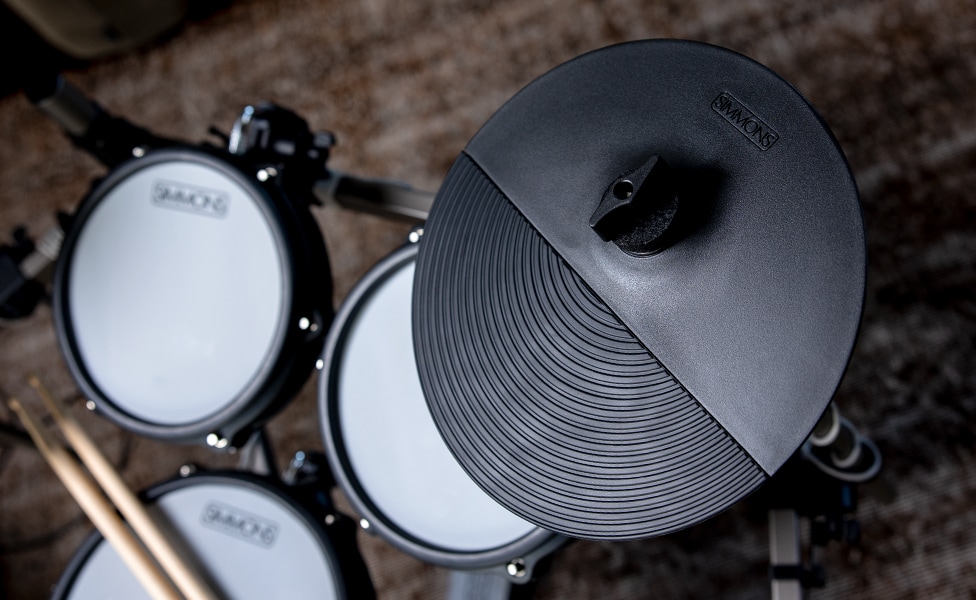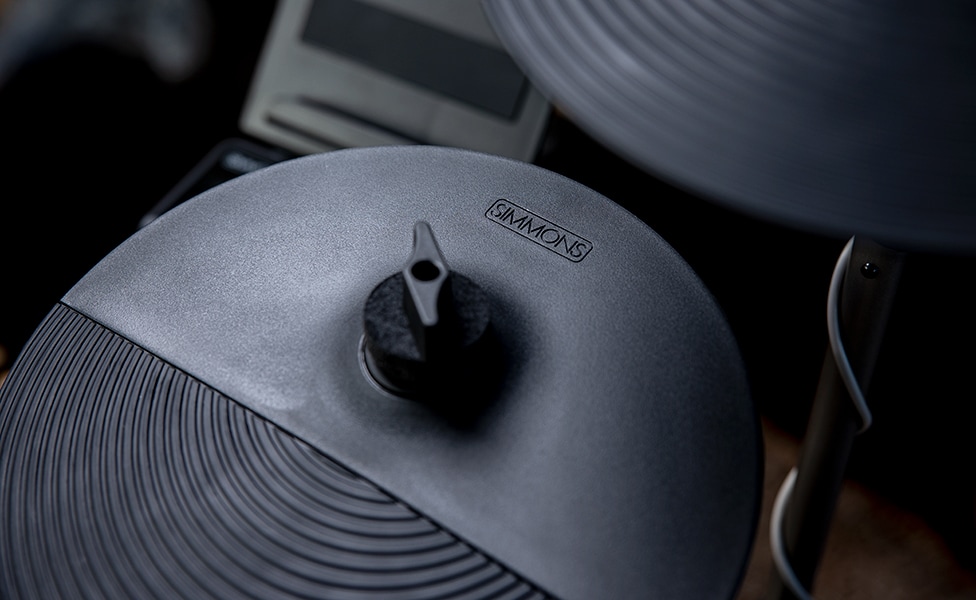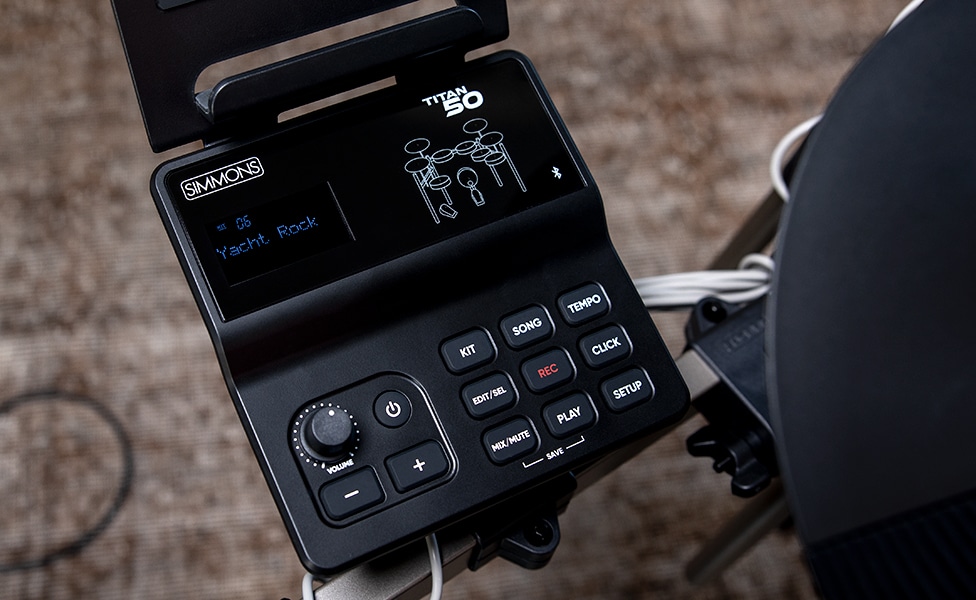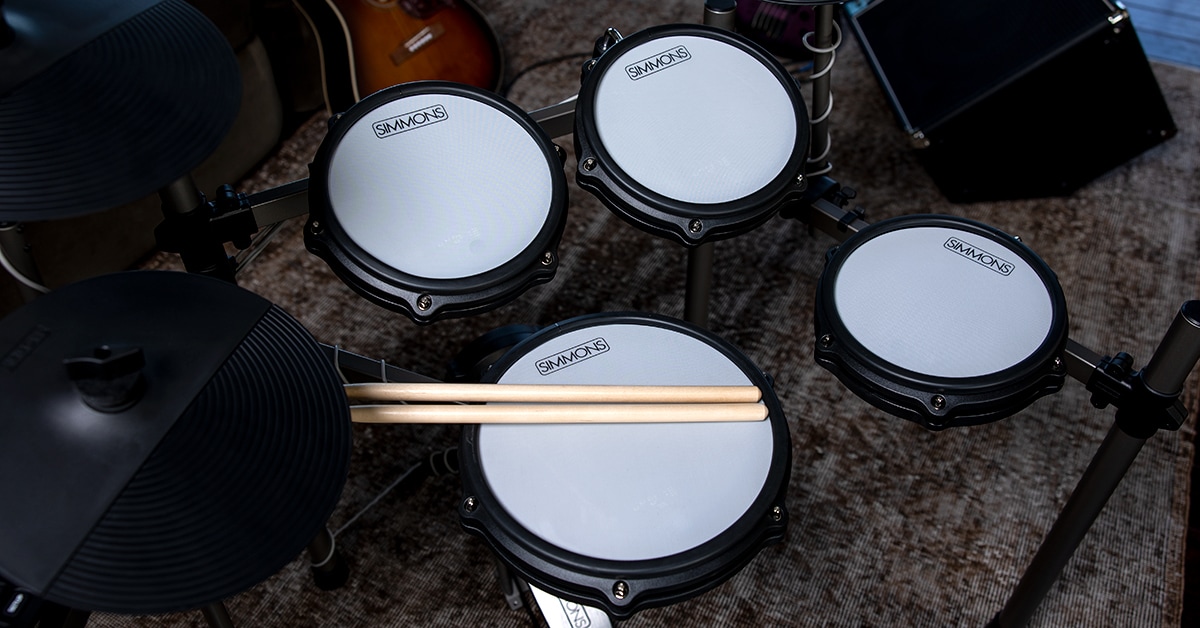Simmons electronic drums were all the rage during the 1980s new wave explosion, driving hits by Duran Duran, Spandau Ballet and other fashion-forward acts. But the Simmons concept attracted more than Top of the Pops bands in shocking makeup and bizarre costumes. The innovative kits also inspired technically brilliant drummers, such as Bill Bruford (King Crimson), Neil Peart (Rush), Danny Carey (Tool) and Alex Van Halen to dig deep into synth and sample programming, pad layering, velocity triggering and playing truly unique percussion sounds.
Fast-forward to now, and the brand-new Simmons Titan 50 offers mesh pads for an authentic acoustic drum feel, a savvy no-slip rack for drum pads, the best sound library the company has ever produced, intuitive editing and practice tools, and enhanced connectivity—with everything at an affordable price. The Titan 50 has an expandable setup with 25 stereo presets and space for 10 user kits. The compact Titan 20 offers 10 mono presets (although a stereo soundscape is produced when you mix the stereo reverb with a preset) and 1 slot for a user kit.
The Titan 50 required a complete rethink of what an electronic kit should offer for today’s beginning and more experienced drummers. Simmons product manager Jeff Laity takes us through the process of evolving the company’s e-kit strategy, devising the features and specs, recording the samples, refining the sounds and testing and manufacturing these latest additions to the Simmons legend.
How have things evolved and changed for electronic drums since Simmons produced the first completely electronic kit, the SDS-V, in 1981?
Jeff Laity: In the 1980s, synthesizers and digital sampling were brand new, and the style of music at the time was driven by everyone wanting unique and innovative sounds. It was all about sounding different, and Simmons allowed drummers to explore that aspect of music making.
As time has gone on, electronic drums have gradually become popular as practice kits. So, many of the design goals and innovations have been about providing a playing experience closer to an acoustic kit, but with a headphone jack included that facilitates almost-silent practicing at home. That’s the ideal for many people.
What goals and features were you addressing as you developed the Titan 50?
Technology is always improving, but as electronic drums are primarily musical instruments, what I push for, first and foremost, is to have them sound great and feel great. We could have lots of flashy technological features, but if we don’t get those two qualities right, then it's not really a successful instrument. The Titan 50 includes some classic synth sounds that people love from the ’80s, but it also has fantastic acoustic-drum sounds. In addition, the mesh heads really feel like you’re hitting conventional drum heads, so the playing experience is extremely satisfying.
On the tech side, we've integrated Bluetooth and a Simmons app that offer some excellent practice tools to help you become a better drummer. There are different ways you can customize the kit, as well, but most importantly, you’ll have a lot of fun playing it.

Did the current SD series of Simmons kits play into the design of the Titan 50?
We learned a lot from producing the SD series, and that helped us redesign the Titan 50 from the ground up. We worked with industrial designers and engineers to focus on every detail, so the Titan 50 is really a new kit. There's almost nothing in common with previous SD drums.
We went deep on the rack, pad and cymbal designs—even settling on the cable clips was a long process to get them where we wanted. The new rack is solid steel and rectangular, so your pads won't slip as you play. The drum clamps are designed to minimize the number of adjustments a player would need to make. On a tom clamp, for example, there's one piece to loosen. Then, you can move it up and down, or rotate it, or anything else you want to do. When the tom is where you want it, you just clamp down that one piece.
We recognized that the way a player configures their kit is very personal—no two drummers set up their kits alike. So, we worked to make the Titan 50 very flexible, quick and simple to set up.
Do you have any insights on which improvements might be the most meaningful for players?
Well, hopefully, the sound and the feel of the kit. On a lot of e-kits, you’re almost playing at an angle to get to the pads, because the rims are very tall. We made the rims as low profile as we could to offer a playing feel that’s more like that of an acoustic kit.
And a more consistent triggering experience, right?
Yes. You're not accidentally hitting the rims when you're trying to play the kit.

Let’s talk about the sound design for the Titan 50. How did you approach crafting the individual drum sounds and kit presets?
In the past, we've recorded different brands of drum kits, but for the Titan 50 sound library, our goal was to go after specific musical styles. I think a lot of players—especially when they start out—have a sound or a band in mind that they want to emulate. They have something in their head that they want to sound like. If you can get a tool that gives you that type of sound, you're immediately inspired to play, practice and become a better drummer.
So, we wanted our heavy rock kit to sound like a Foo Fighters record. For metal, we wanted to capture the vibe of the drums on Metallica’s “Black Album.” While the brand of kit was still very much a part of the sound design, we also looked at the microphone positions, the mixdown chain and everything that went into getting the sound of that type of record. It was less about, “Let's get a DW kit,” or, “Let's get a Gretsch,” and more about nailing the actual drum sound of different musical styles.
And a complete, highly produced drum sound at that.
Definitely. On an acoustic drum set, there’s often a big learning curve regarding tuning the drums and setting them up, and it's still not going to sound like you're miked up in a big commercial recording studio. Whereas, with an electronic kit, you can dial up a preset and get immersed in a sound that is almost like what you’d hear on a record. That’s inspiring.
What was most special about the sampling sessions?
We put together a really good team and went to London Bridge in Seattle—a big, famous studio that recorded a lot of ’90s grunge records by bands such as Pearl Jam and Soundgarden. The recording engineer was Don Gunn. He’s a drummer himself, and he has worked with a lot of bands in many different styles, such as King Crimson, Peter Frampton and Death Cab for Cutie. He knew where to find the kits we needed for the sampling sessions. Our drummer on the sessions was Ben Smith, who played with Heart for many years.
We set up 22 different mics in the room, which gave us a lot of options for all the sounds we wanted to get. For each type of kit we recorded, we got the correct heads, ensured the tuning was accurate and studied the signal processing and treatment. We spent a long week listening to somebody hit a drum over and over, but we're really happy with the results.

Once you left the studio, was everything done and ready to go?
The process didn’t stop with the sampling sessions. We had to take those samples and turn them into the instruments that live inside the Titan 50 sound module. That required a lot of fine-tuning and testing by the amazing drummers on our team. For example, you don’t want a super-loud sound when you’re playing with a medium- or low-level attack.
It took us a long time to get the velocity and trigger curves just right, because drums sound very different when you smash them, versus hitting lightly. We took multiple samples from soft to loud, and dialed in the transitions to be very smooth. You don't want to hear abrupt level changes.
Another thing we did is called “round-robin sampling,” which alternates different samples in the same dynamic range. It was important to do this, because if you were to, say, play a snare drum roll with the exact same sample being triggered over and over, it would sound robotic. With different samples, the sound of the snare attacks more accurately emulates the slight variations of a human drummer, which produces a more realistic and pleasing result to the ear.
There’s also the option to customize sounds, right?
Yes. As people grow as drummers, they may want to go beyond the presets, and you can edit the Titan 50 kits. Maybe a player likes most of one particular kit, but prefers the snare drum from another kit. Well, you can swap out that snare very easily. You can also change the pitch and damping of the samples to get different sounds the way you would on an acoustic kit. There's a lot of mixing you can do, as well. Obviously, you can control volume and panning, but there’s also a compressor that sounds really great and lets you change the punch and sound of the entire kit. If you want more room sound, you can use the onboard reverb to dial in the ambience you want.
What are some of the practice tools the Titan 50 provides?
The new practice mode is designed for drummers who are just starting out. For example, the most important thing a drummer must learn is how to keep a steady tempo, and we include songs where you can play along with a meter that shows whether you're ahead of the beat, behind the beat or right on the beat. When you're finished playing that song, you get a score of how well you did. There are different exercises and levels of difficulty, so you can continue to improve at any skill level. We think the practice mode is really fun, too.

Are those tools available in the module, or do you need the Simmons app to access them?
They are built right into the kit’s sound module. A lot of what the app provides is a different way to interact with what the module already is doing. The app gives you a larger screen to see what’s going on with the kit, but the module lets you select and edit kits, change the mix, choose different practice exercises and so on.
Can you touch upon the Bluetooth audio?
That's a new feature in the module, and it’s easy to set up. You can place your phone or tablet on the module's iPad shelf and dial up a YouTube video to play along with things in your music library. It all plays through the same speaker or headphones that the drum sounds are coming through. Bluetooth MIDI is also available to connect to the Simmons app for iOS and other apps.
How do you integrate the Titan 50 into a home studio?
Another feature of the module is that it functions as a USB audio and MIDI interface. When you connect to a computer, the drum sounds you play on the module can be recorded into your DAW. You don’t have to switch back and forth between playback systems to hear what you did, either. The tracks from your DAW go through the Titan 50 module and are audible through the headphones or speakers you’re using to play the kit.
What are main differences between the Titan 50 and the Titan 20, and what type of player would likely choose one or the other kit?
The Titan 50 was designed to accommodate beginners and advanced players, so it’s a great, all-around kit for any skill level. The Titan 20 is a more affordable option for a young student who wants to see if drumming is right for them, or perhaps for a parent or grandparent who wants to purchase the kit as a gift.
The key difference is that the Titan 20 is not expandable. The Titan 50 offers an expansion kit if you want to add more toms and cymbals as you grow with the kit. The Titan 50 also has stereo sounds, while the Titan 20 samples are mono. The Titan 20 is more compact, yet it still includes the app support, mesh pads, rectangular rack, tablet shelf, Bluetooth, MIDI, USB and a lot of the same sounds we recorded for the Titan 50.
Do you have any recommendations about which presets someone should initially audition if they were playing the Titan 50 at their local Guitar Center?
The first four kits are completely different acoustic kits that sound great, so they’ll give you a fantastic look at what the Titan 50 offers. When you play, you'll hear the complete stereo perspective of the room the drums were recorded in. I wouldn’t think you’d need to call up every preset to get a feel for the kit, because we went for quality over quantity when creating the sounds. We didn’t want to quickly fade out tom decays and cymbal rings just so we could jam in more drum sounds. We wanted all of the samples to sound natural and realistic—even if that meant including a seven-second cymbal decay.










